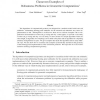Free Online Productivity Tools
i2Speak
i2Symbol
i2OCR
iTex2Img
iWeb2Print
iWeb2Shot
i2Type
iPdf2Split
iPdf2Merge
i2Bopomofo
i2Arabic
i2Style
i2Image
i2PDF
iLatex2Rtf
Sci2ools
ESA
2004
Springer
2004
Springer
Classroom Examples of Robustness Problems in Geometric Computations
The algorithms of computational geometry are designed for a machine model with exact real arithmetic. Substituting floating-point arithmetic for the assumed real arithmetic may cause implementations to fail. Although this is well known, there are no concrete examples with a comprehensive documentation of what can go wrong and why. In this paper, we provide a case study of what can go wrong and why. For our study, we have chosen two simple algorithms which are often taught, an algorithm for computing convex hulls in the plane and an algorithm for computing Delaunay triangulations in space. We give examples that make the algorithms fail in many different ways. We also show how to construct such examples systematically and discuss the geometry of the floating-point implementation of the orientation predicate. We hope that our work will be useful for teaching computational geometry.
| Added | 01 Jul 2010 |
| Updated | 01 Jul 2010 |
| Type | Conference |
| Year | 2004 |
| Where | ESA |
| Authors | Lutz Kettner, Kurt Mehlhorn, Sylvain Pion, Stefan Schirra, Chee-Keng Yap |
Comments (0)

